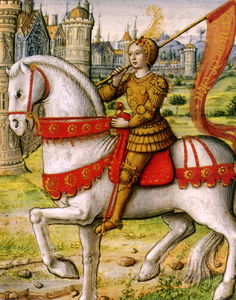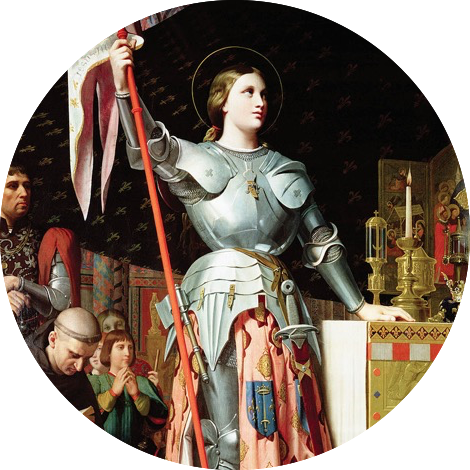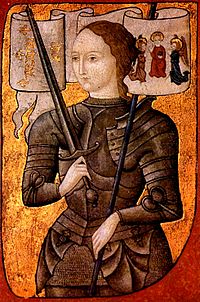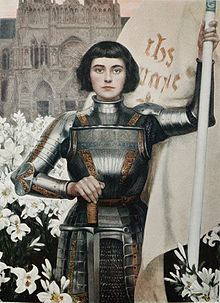Joan of Arc: burnt at the stake for wearing the trousers
In a poem, William Wordsworth called Joan of Arc “a perfect woman…”, Winston Churchill wrote “…she finds no equal in a thousand years” and Mark Twain capped them all with: “By far the most extraordinary person the human race has ever produced.”
High praise, but just who was she, this Joan of Arc—and what’s her claim to fame? An extraordinary military genius and kingmaker who united France in the Middle Ages—or just a jumped-up, androgynous teenage transvestite who wore the trousers in a world of powerful medieval men?
Well, to help you decide here’s a very brief synopsis of the protracted and convoluted story of her short life.
Joan of Arc’s life
A long long time ago, in the fifteenth century, Jeanne, later to become La Pucelle d’Orléans, had a bevy of divine connections who got in touch with her regularly, it seems.
One day, when talking to them, they suggested that she help Charles VII to become king of France—and get rid of the English while she was about it.
After she’d crowned him king, she became a kind of armoured mascot in the army. Charles then sent her to relieve Orléans against la perfide Albion. But she was captured by the Burgundians who were English allies (…you were warned that this would be convoluted…) and eventually handed over to the Bishop of Beauvais. He’d been after her for a while because the Church didn’t like cross dressing peasant girls who spoke directly to saints in heaven.
So, they charged her with witchcraft.
But, this wouldn’t stick because, when they checked, they discovered she was a virgin. This meant, apparently, that she couldn’t be a witch.
So, she was then tried for wearing men’s gear—and condemned to burn for heresy. But, to avoid the stake, she recanted and was simply sent to prison.
Alas, a few days later she was at it again—wearing men’s pants in jail. This relapse was the last straw and she was burned alive in Rouen in 1431.
Joan of Arc: hero or enemy?
Today, unfortunately, Joan’s considerable achievements have been hijacked, exploited and mythologised by a hodgepodge of quite opposing factions.
- French monarchists used her as a symbol of their support for the king.
- Napoleon embraced her as a French nationalist.
- The Catholic Church burnt her to death as a heretic.
- Then they rehabilitated her—and then canonised her.
- So now she lives in heaven.
Joan of Arc: political symbol?
- Joan wore suffragette colours on both sides of the Atlantic when she took up the women’s cause. She brandished the Women’s Social and Political Union’s banner riding through London in the 1928 march, demanding equal voting rights for women.
- In World War One, the Allies used her as propaganda to get women to buy war bonds.
- During the Nazi occupation, German posters reminded the French about her corrupt trial at the hands of the English—and she appeared on billboards showing the Allied bombing of Rouen with the caption:
Les assassins reviennent toujours sur les lieux de leur crime.
- At the same time, De Gaulle and les maquisards were using her Croix de Lorraine on the French tricolore as a representation of French unity.
- Petain saw her as the embodiment of Vichyist values. To him, she was Anglophobia, anti-Semitism, and anti-Republicanism all in one person.
- Brigitte Bardot, once the sex kitten of French movies—now just a jaded animal rights activist—calls the National Front’s Marine Le Pen “the Joan of Arc of the 21st century.”
- And in brand advertising, Joan likes Kidney Beans, Chilli Beans, and Pinto Beans.

Although Joan of Arc achieved what should have been impossible for a woman in the 15th century, the world appears to have been sucked in by a mishmash of revisionist or distorted representations of her feats.
Fortunately, today’s feminists appear to have reassessed Joan as a symbol of women’s emancipation and equal rights.
Joan of Arc: divine or mortal?
So… maybe she was just a mere mortal after all.
Someone who believed in the now preposterous, but then powerful and universal belief in the divine right of kings.
And in those fairies who apparently spoke to her—but perhaps only from the bottom of the garden.
Do you think Joan of Arc is still a hero and an activist? We would love to hear your thoughts in the comments box below.
Image credits
1. Circular Joan portrait, via Wikimedia.
2. Joan with sword, via Wikimedia.
3. Joan at castle, via Wikimedia.
4. Joan on horseback, via Wikimedia.










Thanks for this article, Ray! I don’t claim to know much about Joan of Arc, but I would definitely describe her as a symbol of female emancipation for today’s modern feminists.
Bonjour Beth,
Thank you for reading my perspective on Joan of Arc—and apologies for this late reply. Naturally, I agree that Joan undoubetedly played a powerful feminist role—and long before gender differences were even thought about. But the thing that interests me most is how her image has been appropriated by such a wide range of diverse causes and interests—many of them without a jot of femenist sympathy.
Thanks again for your post and comments.
Amicalement.
Ray
It’s fascinating to note just how prolific her image has become, and how it has come to represent a diverse but entirely unrelated range of values!